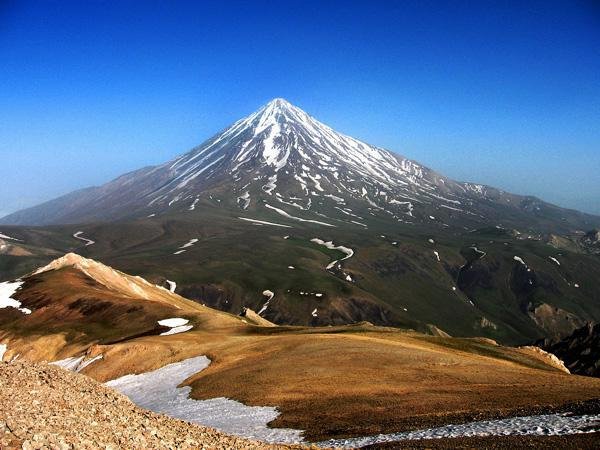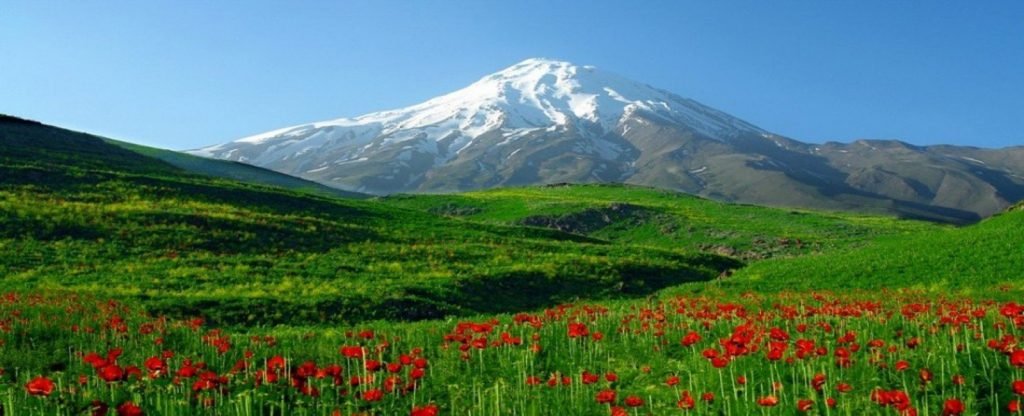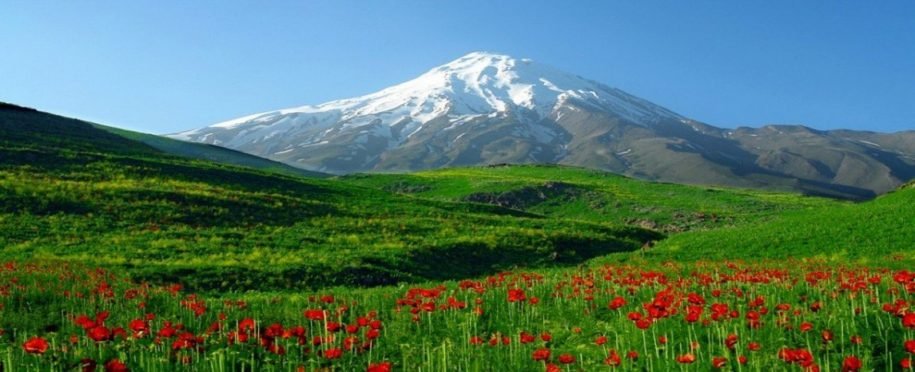Damavand Peak
Mount Damavand is known as the highest mountain in Iran and a volcano in the Middle East. It is located in the central part of the Alborz mountain range (central Alborz), and in the south of the Caspian Sea,
Damavand Peak which is located in Mazandaran province has the altitude of 5610 m, according to the National Iranian Statistics; however, according to some other sources, including the National Geospatial Data Base of Iran and the NASA Earth Observatory website, the heights of 5670 meters and 5671 meters has also been declared for Damavand. The Climbing Federation of Iran has recently announced: “It recognizes the height of 5609.2 meters for Damavand Peak.”
Damavand Mountain General Information
| Elevation (meters) | 5609 m |
| Popular Routes | Southern Route |
| Rating | YDS Class 2 |
| Elevation Gain (meter) | 2,609 m |
| Distance (kilometers) | 16km |
| Route Type | loop |
| Climbing Season | All Year |
| Permit Requirement | yes |
Climb Damavand
Climbing to the summit of Damavand is the desire of many professional climbers and hikers all around the world. Not only its technical challenges attract the professionals, but its breathtaking nature and landscapes call for semi-professionals as well. Also in recent years and with the growing number of tourists traveling to Iran, Trekking Iran Nature has become a trend.
The following information of this article is for those who want to climb Mount Damavand and they need to know the basics like: familiarity with the route, food program, carrying backpack and equipment, acclimation and its approaches, drinking water, the most essential equipment that should be provided, physical and the environment hazards. It’s vital to know, what level of physical fitness you need to have; In what months of the year you should climb; What days of the week you should climb; The climbing should start at what time of the day and what pace; And many more basics.

What physical fitness is needed for climbing Damavand?
Sufficient physical fitness is the first necessary condition to climb Mount Damavand. Climbing the Damavand Summit from the southern route is an almost easy climb for those who regularly go hiking and trekking and have enough physical fitness. Of course, the sulfur gas spill near the summit might need more effort for the final climb.
What months of the year are better to climb Damavand?
Mount Damavand’s weather in April and May is very unstable and with a high chance of big sudden storms. These factors can disrupt climbing programs and increase the risks and hazards of climbing. The best time to climb Damavand peak is between July and August. During this period the footpaths are usually free of snow, the weather is relatively mild and access by public transportation to the basecamp is easy, but the mountain shelters are crowded. As we go from August to September, the area will be drier and face sudden changes in the climate. From mid-October to around mid-May climbing to the summit is risky due to extreme wind and weather conditions, snow and ice.
What days of the week are better to climb Damavand?
This point is more important on the southern side of Mount Damavand. Since it is the easiest route to climb, the presence of countless climbers along this path brings too much crowdedness and noise, and apart from killing the experience, it will cause some other issues like preventing a good rest and having an easy climb. This issue is quite visible on weekends (Thursday and Friday are the weekends in Iran). Therefore, it is recommended to climb this route on the first days of the week.
In the third barrage, in addition to the two existing shelters, some flat and suitable grounds have been provided for tent construction. However, due to the presence of climbers from all parts of Iran on weekends, there may be shortages of space for tents in these spaces.
What time of day is better to climb?
According to many climbers, due to the effect of the day heat and sunlight on sulfuric rocks which spread the smell of sulfur, it is better to climb in the dark of the night. But it seems that sunlight does not have much effect on this factor, and the value of resting during the night and climbing the summit with more energy in the early morning has a particular priority.
Being familiar with the area and the ascent route
If you are entering this area for the first time, it is better to climb with locals or co-climbers who are familiar with the area. Although there is a vivid path along the climb, but the gravel stones in the path, sudden changes in the weather, and other unexpected issues may cause problems during the climb. The easiest way to climb Damavand is from the southern route, with better facilities for climbers in Rineh and Poloor village. if you are looking for a local guide we also offer guide with different options. contact us for more details. Contact Hi Tehran Hostel

Food program and nutrition Diet
As it has been mentioned frequently, the best foods for mountaineering are low-volume and high-calorie foods, to help to decrease the weight of your backpack and, do not fill up the capacity of your stomach and harden your breathing while climbing. Also, food types that should be used are the ones which don’t get rotten easily, especially in warmer seasons. The main part of every meal can be honey, jam, dates.
Fellows and Co-Climbers
For group climbs, there are some tips to have in mind:
- It is better that at least one member of the group has already climbed to the summit of Damavand;In the last phase of the climb, from the last refuge to the summit, if there are companions in the group that there is no complete assurance about their ability to climb, it is better to refrain from the final climb so that other group members do not get disturbed; or Before the climb, a member of the group can be volunteered to return and accompany the semi-professional individuals from the ascent.
Carrying backpacks and instruments
It’s better not to take heavy, extra, unnecessary gears. To carry the loads up to the last shelter, you can use livestock to reserve more energy to the final climb with less fatigue. From the Goosfandsara (Sheep House, Camp II Damavand) to the third barrage (Camp III), there are locals who use the mules to move the gear up and you can use the service. At the final stage of climbing the summit, remove the necessary gears and put them in a smaller backpack for the final climb.
Acclimation or height alignment
The gradual process of matching the body with oxygen deficiency in high altitude is called “Climbing acclimation”. This adjustment makes it easier to deliver more oxygen to the cells and also improve oxygen utilization. There are significant individual differences in the ability of individuals to adapt to altitude. Some, quickly adapt to altitude, while others have acute mountain eardrums and require longer periods of time to sync with the altitude.
The most important signs and symptoms that occur until you are fully synced with existing air are headaches, nausea, and dizziness. To cope with weathering complications and more readiness for the final climb, one can well deal with this problem by doing a climb of 4,500 meters high and returning to the shelter. In case of more serious problems and severe symptoms, take the person to the lower altitudes quickly and get help from professionals who are familiar with the first aid till reaching the official medical help.
Drinking water
The water springs at the higher altitudes of this area freeze during the night. So, to access water should be done in the heat of the day and before the freezing of water again. Of course, due to the small number of impurities and tastes of water, water purifying tablets can also be used. Access to drinking water on the northern route is a bit more difficult than other routes, and it may be necessary to melt snow to provide water.

Along the way to Damavand Peak:
One of the first important points in climbing activity is slow and steady moving, which is important in several aspects. The division of energy for the entire path is possible with slow and steady steps, especially on longer paths with greater slopes. Also, enjoying the mountains and climbing activities are not only reaching the summit, but the entire length of the route and its various attractions can be enjoyable, and the goal of climbing the summit is to use all the attractions of the path. Especially, on the way of amazing and spectacular Damavand.
Taking steps slowly, breathing deeply (snorkeling from the nose and exhaling from the mouth), drinking sweetened sugary liquids and very short breaks along the way make it easier to reach the summit. Having a light camera to record the moments and climbs of your surroundings or even going for pro photography will help to capture the climbing special moments. On the way of returning from Mount Damavand, you can rest in different parts of the region and enjoy other attractions, especially bathing in the mineral hot water of the Larijan spa, which, in addition to having the health benefits, will alleviate the fatigue of the climb to a large extent.
The most essential equipment for climbing Damavand:
Large backpack or bag to carry your gadgets with a mule, a small backpack for climbing equipment on the route, bag cover or collar, proper tent for the height, sleeping bag (with a Comfort -10 temperature), whistles, climbing batons, jackets and windbreakers Or Gortex, Polar jackets and trousers, First layer shirts and trousers, Second layer shirts, Suitable climbing shoes, Woolen soles or hand towels (2 sets), Anti-storm hats, Sleeveless gloves, Polar and stuffed, Sunglasses, Headlamp, additional battery for headlamp, gas cylinder, necessary container (knife, cup, spoon, fork …), thermos or bottle of water, GPS, camera, mobile and Power Bank, toothbrushes and toothpastes, paper napkins, wipes, notepad and pen, yarn and needle, personal first aid kit, sunscreen cream, identity card, and if you are under certain treatment you should take your medicine for sure.
Hazards of climbing Mount Damavand
Mount Mount Damavand is not one of the most difficult due to its height. But due to the atmospheric pressure at its summit which is 456 mm Hg, and the usual climbing risks may cause some problems for the climbers.
Environmental hazards on Damavand Peak:
- Cold
In the winter, during a storm and a blizzard, the temperature reaches 40 ° C minus zero at mid-way of the summit. This low temperature also depends on the direction and side of the mountain range. The north face is the coldest route of Damavand, and the temperature sometimes reaches minus 50 ° C. The southern route is the second point on which the cold dominates since it is in the shadows until noon and mid-day. Therefore, climbing in such a situation requires its own experience and equipment, and climbers who do not consider this simply face the risk of freezing and then amputation of the organs.
- Storm, fog, and wind
Damavand volcano pyramid is located in an open space and the storm strikes from every side prevent air humidity flow from the north and west sides. As a result, a cloud hat will be formed around the summit. In such a situation, snow falls, hail or strong wind blowing is possible. These conditions are also dangerous for climbers. In the winter, especially on the west side of the mountain, there are lots of storms, winds, fog and the clouds which cause losing the paths.
- Snowslide
The wind blows cause the accumulating snow in the holes, and eventually the avalanche to fall, especially in the late winter and early spring on the south route, there is a chance of snow avalanche. The avalanche crashes in Damavand are frequent, so the familiarity and identification of the avalanche route are essential to avoid the danger.
- Landslide, rock and mudslide
With the onset of summer and snow melting, this risk will be higher than ever, especially in the western route where rocky materials are unstable, and with the slightest pressure, there will be a slide. In the spring, there is a risk of rock falls in the glaciers.
- Physical hazards on the summit of Damavand
Damavand always has its own hazards due to its high altitude for climbers who are not physically ready or don’t have enough experience. Developing height related symptoms which usually appear as headaches, nausea, or dizziness are the signs which should be taken seriously by every climber. It means, the climber shouldn’t keep up the route and has to go back as soon as possible.
Access to Camp Damavand Base
To reach the Damavand Main Camp, which is also called the Base of the Climbing Federation, you can ride to Poloor through Haraz Road. Haraz road or road 77, along with road 59 (Karaj-Chalous), are the most important roads in Tehran-Mazandaran which are also the closest way to Damavand Mountains. The Haraz road is one of the most beautiful and historic roads in the world, selected by the Iranian people in 2010, as the most beautiful road in Iran. This road is the shortest route between Tehran and Amol.
Writer: Golnar ZAMANI
Book Your Stay at Hi Tehran Hostel Now
Book your stay at HI Tehran Hostel , Also if you have climbing and trekking in Iran on your mind, our guide will help you! You Are Invited!



5 Comments
Hugo Monnet
Thank you for all this information. I would like to book 3 beds in the huts of Damavand, Do you know to who and where to ask ? Thank you very much
HI Tehran Hostel
Glad to hear that, Dear Huge there are many huts in each route, depending on your desired path you have different options and huts can be booked on http://portal.msfi.ir/Login.aspx, unfortunately this website is in Persian.But if you booked your stay at Hi Tehran Hostel, our staff will help you out on this when you arrive.
Jorge
Good afternoon. I am thinking about climb Damavand with skis. Can you explain me how much snow there is in the mountain at the end of Mars and the beginning of April. When is the best moment to do it? I mean, the time of the year when you can ski further down. Cheers
HI Tehran Hostel
Dear Jorge Indeed end of March wont present you as much quality as it should. The best seasons are mid-Jan to mid-March. However it really depends on the weather as well.
Parham Rashidi
Thank you for your information. Are there any special requirements needed for the climb? (especial experience, licence, etc)